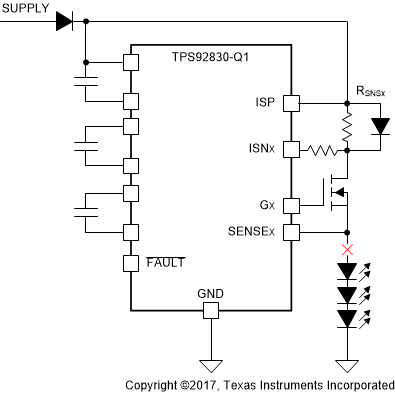SLIS178B October 2017 – January 2018 TPS92830-Q1
PRODUCTION DATA.
- 1 Features
- 2 Applications
- 3 Description
- 4 Revision History
- 5 Description (Continued)
- 6 Pin Configuration and Functions
- 7 Specifications
- 8 Detailed Description
- 9 Application and Implementation
- 10Layout
- 11Device and Documentation Support
- 12Mechanical, Packaging, and Orderable Information
Package Options
Mechanical Data (Package|Pins)
- PW|28
Thermal pad, mechanical data (Package|Pins)
- PW|28
Orderable Information
8.3.7.5 Dropout-Mode Diagnostics
When the input voltage is not high enough to keep the external N-channel MOSFET in the constant-current saturation region, the TPS92830-Q1 device tries to regulate current by driving the external N-channel MOSFET in the linear region. This state is called the dropout mode, because voltage across the sense resistor is not able to reach the regulation threshold.
In dropout mode, LED open-circuit detection must be disabled via the DIAGEN input. Otherwise, the dropout mode would be treated as an LED open-circuit fault. The DIAGEN pin is used to avoid false diagnostics on an output channel due to low supply voltage.
When the DIAGEN voltage is low, the LED open-circuit detection is ignored. When the DIAGEN voltage is high, LED open-circuit detection resumes normal operation.
In dropout mode, the MOSFET is driven at maximum gate-source voltage to regulate current to the desired value. When the supply voltage increases, the MOSFET gate voltage is pulled down internally by a control loop. If the supply-voltage slew rate is fast, a high-current pulse can be observed on the LED for a short period of time. At the same time, the current-sense voltage may exceed the normal operating range and damage internal circuitry. A parallel diode or a current-limiting resistor less than 1 kΩ is recommended to clamp the voltage across the sensing resistor in the case of a large pulse current.
 Figure 30. Resistor and Diode for Sense-Resistor Protection
Figure 30. Resistor and Diode for Sense-Resistor Protection